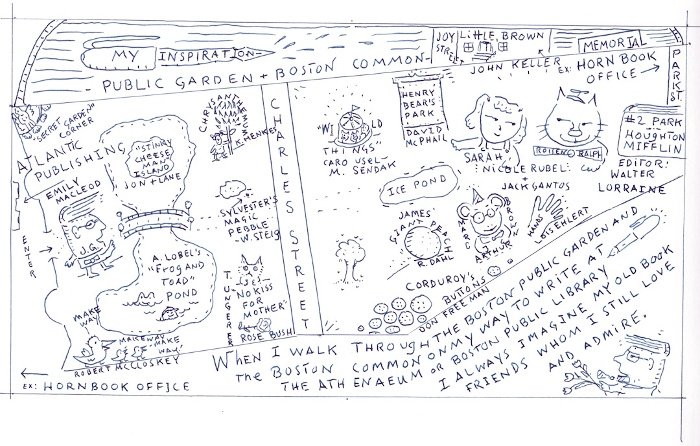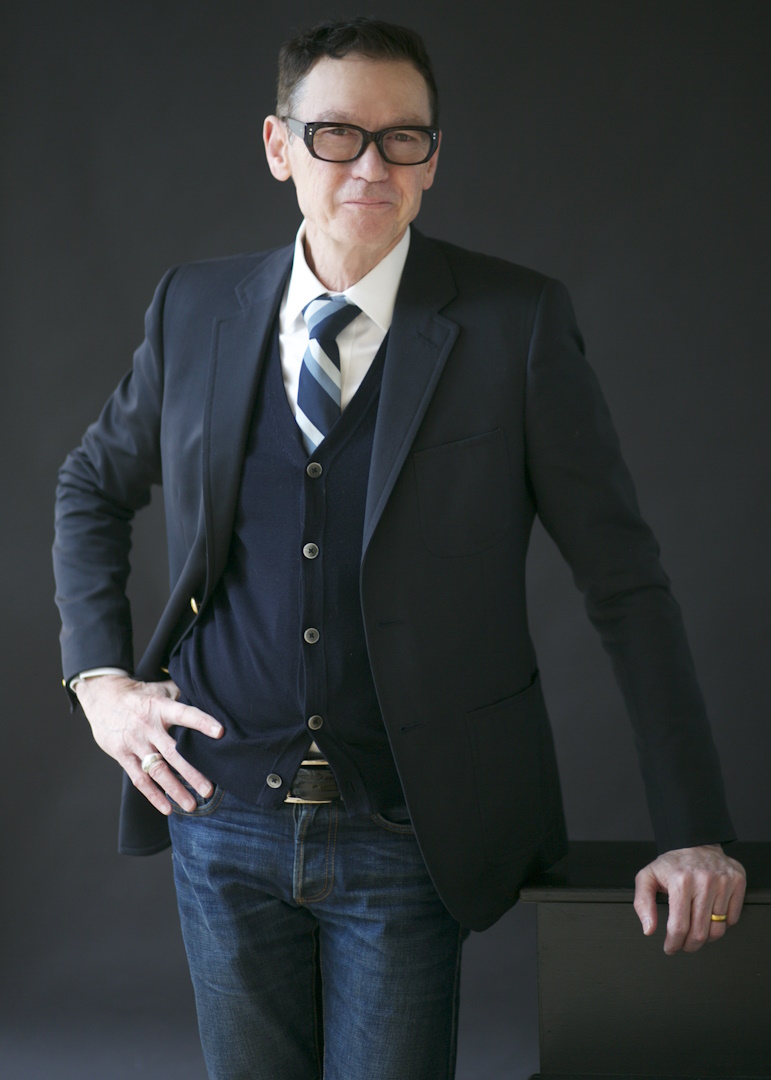The Writer's Page: Mapping My Path
How did I end up in the picture-book world? It was all because of Nicole Rubel, the brilliant illustrator of the Rotten Ralph books, among many others.
How did I end up in the picture-book world? It was all because of Nicole Rubel, the brilliant illustrator of the Rotten Ralph books, among many others.
I was a creative writing student at Emerson College, and I was still on parole after an unsuccessful attempt to smuggle a ton of hashish on a sailboat from St. Croix, in the U.S. Virgin Islands, to New York City. (I was broke, and the plan was to make tuition money for college.) As an ex-con, I was definitely the wrong profile for a picture book writer — or so I thought.
Anyway, I had a work-study job at Emerson as an evening security guard, and some theater friends had invited me to a costume party. I liked wearing costumes as it was so much easier being something I was not. When I got off my shift, I went into the Emerson Theater costume shop — and I chose a huge White Rabbit costume. The body was fluffy on the outside and filled with foam on the inside. Once I forced my way down into it, I looked like a three-hundred-pound rabbit. My arms stood straight out, the head was oversized, and with my enormous ears, I was about eight feet tall. I left the costume shop on Berkeley Street in the Back Bay and walked stiffly through the tree-lined mall of Commonwealth Avenue toward Kenmore Square, about ten blocks away. The eye holes on the costume did not line up with my eyes, and the rabbit feet were as large as couch pillows. If I had stumbled and fallen over, I’d never have gotten back onto my feet. This was 1975, a wildly expressive era, so I fit right in.
After a slow walk, I arrived at the party — it was crowded. I adjusted my gigantic rabbit head so I could see and made sure not to hit the ceiling fan with my ears as I inched around the walls looking for a kitchen — and a drink. I felt I deserved one. I had no idea how I would drink a cold beer, but I found a “long-neck” bottle and I willed that rabbit costume to open its mouth. Once I accomplished the beverage portion of the party, I wasn’t sure how I would meet people, but I figured the costume would speak for itself.
And it did. A clever Museum School artist — aptly dressed as Alice (from Wonderland) — introduced herself to me. Her name was Nicole Rubel, and she was very funny. We had a long conversation. She liked illustrated children’s books, and I’m sure I overstated my skills when I declared that I could write them. I don’t think I had ever had writing books for children as an ambition in my entire life, but at that moment it seemed to be a great goal.
And so we began to collaborate. My first story was titled “A Visit to Grandmother’s House.” It was a timid subject, but with being on parole I felt a bit self-conscious writing books for children, so I was attempting to be gentle and overly cautious, which was a mistake. The story was long and leggy and dull in an all-too-sweet way. I think it would have taken a kindergartner until they were in fourth grade to read it. Nicole did a great job with the illustrations, and soon we were ready to pitch it to a children’s book editor.
In those days there were three terrific publishers in Boston — Houghton Mifflin at #2 Park Street; Little, Brown up at #34 Beacon Street; and Atlantic Monthly on the corner of #8 Arlington Street and Marlborough Street (see map below).
We called Houghton Mifflin first and asked for the children’s book department, and the great Walter Lorraine’s secretary answered the phone. Because we had a complete dummy of the book — story and illustrations that we pasted up in a blank book — she scheduled us for an appointment with Walter. At that moment we thought, this is going to be easy.
Walter was generous, and with an abundance of detail pointed out everything that was wrong with the book — and he made it very clear that the story was hopeless. He did admire Nicole’s art. He instructed me on how to format a forty-eight-page book, and he showed Nicole how to create the art in four-color overlays. Back then, there was no camera separation for the art as there is now. He was no-nonsense but encouraging and said to return when we had another book.
Quickly, I wrote another story. Nicole illustrated the entire manuscript. We made an appointment with Walter. He skillfully took it apart. We left. Weeks later we returned with a third submission, and after he really took that one apart, he asked me if I had read any children’s books recently. I had not. I figured that because I was already a grown-up, I did not have to read them to write them. Somehow, he made the point that “arrogance and ignorance” were not tools of the children’s book trade.
What does he know? I thought. We marched our books over to Little, Brown. The very well-dressed editor, John Keller, turned them down. Then we took them to Emily Macleod at Atlantic. She was welcoming and thoughtful and confirmed everything that Walter and John had said. We canned all of those attempts and began to work on new ideas.
* * *
It turned out Nicole and I were not the only ones trying to get children’s picture books published. Through the revolving doors of coming and going with manuscripts and art portfolios were two outstanding writer-artists: Marc Brown and David McPhail. (David had already had success — and we listened to every word he spoke.) Marc had an aardvark story that he was constantly refining. We would often meet each other in transit between the publishers whose offices were on the perimeters of the combined Boston Common and Public Garden. We’d stop to talk, share writing and art tips, titles of books that inspired us, and notes on our publishing progress. David was encouraging, but said he was now working on something special — something that would get reviewers’ attention. We were in awe of him.
Nicole had always liked Jim Marshall’s books — and Jim had written George and Martha, and Yummers, and What’s the Matter with Carruthers? He lived in Charlestown, so we called him on the phone — told him we loved his books and needed advice. Also, Walter Lorraine was his editor, and we very much wanted to publish with Walter — but we just couldn’t seem to please him. Jim was sympathetic, and he invited us over to his apartment on the top floor of a triple-decker under the shadow of the Bunker Hill Monument. We took many forms of rusty Boston public transportation to get to him, and it was worth every minute of the trip. He was a terrific gentleman, full of life, and humor, and great advice. He was not only encouraging, but also shared tips on how he tailored his stories and prepared the art, which was tricky because in those days it was all four-color hand-done overlays. He encouraged us to keep submitting to Walter Lorraine, whom he called “the brilliant bear.”
After Jim Marshall was so full of good advice, we took a chance and called up Margret Rey of Curious George fame. She lived close to Harvard Square in Cambridge. She answered her phone and said to come over, and we wasted no time in doing so. She greeted us warmly and told us her entire biography — especially the part about how she and her husband fled from the Nazis and ended up in the United States. She was remarkable. Hours passed by, and finally I asked her if she had any tips about pleasing Walter at Houghton Mifflin. I’ll never forget her reply. “I don’t know how to please him,” she said in that feisty voice of hers. “And I don’t try. All I know is that when you sell enough books you no longer go to his office — he comes to your house!” We thanked her, and I staggered back to my rooming house thinking, I better get to work.
Nicole and I kept going back to Walter. He was tough, but as Jim had said, he was brilliant and demanding.Walter always pushed us to constantly refine our stories and art — and to be ourselves. He never promised to publish us, but we felt he was intentionally grooming us — and we were getting better. After twelve rejected books, I finally settled down and stopped writing stories that I thought young readers needed to read, and I wrote a story that made me laugh about a cat named Rotten Ralph. Nicole did her brilliant artwork and brought cleverness to every corner on the page: to the action, to the range of emotions, and to the lively color and compositions. To this day I think the whole Rotten Ralph series captures our best work.
Now, the three publishers that welcomed us and taught us are no longer in Boston, which is unfortunate. In 1976, you could call the editor on the phone and set up an appointment. They helped mentor the talent that came to show their stories and art portfolios — and they are missed.
The first Rotten Ralph book was released in 1976. That same year Marc Brown published Arthur’s Nose with Atlantic Monthly Press, and the same year David McPhail published Henry Bear’s Park with Little, Brown. The old publishers in Boston have moved out or vanished — and the story and art editors who taught us, and took the time to encourage us, are no longer here — but they are well remembered.

Illustration (c) Jack Gantos.
From the May/June 2024 special issue of The Horn Book Magazine: Our Centennial.
 Single copies of this special issue are available for $15.00 including postage and may be ordered from:
Single copies of this special issue are available for $15.00 including postage and may be ordered from:
Horn Book Magazine Customer Service
hbmsubs@pcspublink.com
Full subscription information is here.

RELATED
ALREADY A SUBSCRIBER? LOG IN
We are currently offering this content for free. Sign up now to activate your personal profile, where you can save articles for future viewing.







Add Comment :-
Be the first reader to comment.
Comment Policy: